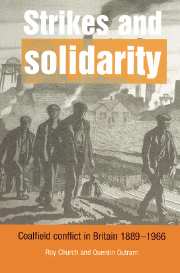Book contents
- Frontmatter
- Contents
- List of figures and tables
- Preface
- List of abbreviations
- 1 Interpreting coalfield conflict: focus and formulations
- 2 Tradition and modernity: the mining industry 1889–1940
- 3 Employers and workers: organizations and strategies
- 4 Employers and workers: ideologies, attitudes and political orientations
- 5 Configurations of strike activity
- 6 Strike participation and solidarity before 1912
- 7 Strikes, organization and consciousness in 1912 and after
- 8 Conflictual context? The ‘isolated mass’ revisited
- 9 Mining and modernity: size, sectionalism and solidarity
- 10 The foundations of strike propensity
- 11 Miners and management: agency and action
- 12 Industrial relations and strikes after nationalization
- 13 International perspectives
- 14 Myths and realities: strikes, solidarity and ‘militant miners’
- General appendix
- List of references
- Index
7 - Strikes, organization and consciousness in 1912 and after
Published online by Cambridge University Press: 04 December 2009
- Frontmatter
- Contents
- List of figures and tables
- Preface
- List of abbreviations
- 1 Interpreting coalfield conflict: focus and formulations
- 2 Tradition and modernity: the mining industry 1889–1940
- 3 Employers and workers: organizations and strategies
- 4 Employers and workers: ideologies, attitudes and political orientations
- 5 Configurations of strike activity
- 6 Strike participation and solidarity before 1912
- 7 Strikes, organization and consciousness in 1912 and after
- 8 Conflictual context? The ‘isolated mass’ revisited
- 9 Mining and modernity: size, sectionalism and solidarity
- 10 The foundations of strike propensity
- 11 Miners and management: agency and action
- 12 Industrial relations and strikes after nationalization
- 13 International perspectives
- 14 Myths and realities: strikes, solidarity and ‘militant miners’
- General appendix
- List of references
- Index
Summary
The solidaristic basis of the first national coal strike
The origins of the first national miners' strike can be traced back to 1908. In that year a legal ruling established that miners paid on piece-rates, as most face workers were, had no legal rights to the customary payments received for working in abnormal conditions or in recompense for other difficulties encountered in reaching normal earnings, unless these were expressly provided for in piece-rate price lists. The case, which concerned a collier employed at the Lady Windsor colliery of the Ocean Coal Company in South Wales, had been supported by the South Wales Miners' Federation (SWMF), and its loss appeared to open the way for a general attack by the coalowners on the payment of allowances. The issue was one of particular concern in South Wales because the geological conditions in the coalfield made the issue more salient than in some other districts (Ness Edwards 1938: 51–2; Arnot 1953: 68; Gilbert 1992: ch. 4).
However, the response to the ruling from the SWMF developed only slowly. Eventually, in 1909, the SWMF annual conference instructed its leaders to ‘take steps’ through the established collective bargaining machinery in South Wales to secure a minimum fall-back wage of 4s 9d per day for colliers working in abnormal places (Ness Edwards 1938: 52). This proposal was duly included as part of a package of measures tabled for inclusion in a new agreement with the coalowners set for negotiation in 1910 at the termination of the then existing agreement.
- Type
- Chapter
- Information
- Strikes and SolidarityCoalfield Conflict in Britain, 1889–1966, pp. 113 - 131Publisher: Cambridge University PressPrint publication year: 1998



